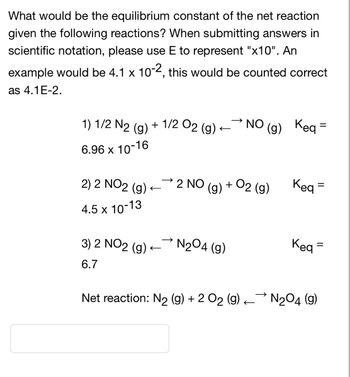
Chemistry
10th Edition
ISBN: 9781305957404
Author: Steven S. Zumdahl, Susan A. Zumdahl, Donald J. DeCoste
Publisher: Cengage Learning
expand_more
expand_more
format_list_bulleted
Question

Transcribed Image Text:What would be the equilibrium constant of the net reaction
given the following reactions? When submitting answers in
scientific notation, please use E to represent "x10". An
example would be 4.1 x 10-2, this would be counted correct
as 4.1E-2.
1) 1/2 N2 (g) + 1/2 O2 (g) -
6.96 x 10-16
2) 2 NO2 (g).
4.5 x 10-13
3) 2 NO2 (g)
6.7
2 NO
NO (g)
N₂04 (g)
(g) Keq =
+ O2 (g)
(g)
Keq =
=
Keq=
Net reaction: N₂ (g) + 2 O₂ (g) N₂O4 (9)
Expert Solution
This question has been solved!
Explore an expertly crafted, step-by-step solution for a thorough understanding of key concepts.
Step by stepSolved in 3 steps

Knowledge Booster
Learn more about
Need a deep-dive on the concept behind this application? Look no further. Learn more about this topic, chemistry and related others by exploring similar questions and additional content below.Similar questions
- In which direction does the equilibrium of this reaction shift due to warming? CO(g) + 2 H₂(g) = CH₂OH(g) O towards the reactants no shift in the equilibrium O towards the products AH-90.2 kJ/molarrow_forwardVanadium metal reacts with oxygen to produce vanadium(V) oxide, V2O5. What amount of V2 05 can be produced from the reaction of 0.340 mol V, and what amount of O2 is consumed? Fill in the amounts table with your responses. 4 V(s) 5 O2(g) 2 V2O5 (s) -> Equation Initial (mol) 0.340 -0.340 Change (mol) Final (mol) Submit Anser Try Anoder ersion 10:28 AM 3/4/2020 FLV here to searcharrow_forward5 Formic acid, from the Latin formica, is the acid present in ants sting. What is the concentration of HCOO at equilibrium if the initial concentration of formic acid, HCOOH, is 3.55 M (K₂ = 1.7 × 10-4). Your Answer: Answer unitsarrow_forward
- (Q97) What is the value of the equilibrium constant (Keg) for the following hypothetical reaction: 2 W (g) + X (g) 3 Y (g) Using the related hypothetical equations should be helpful: X (g) + 1/2 Y (g) W (g) + 1/2 Z (g) K = 0.211 2 Y + Z 3 X (g) K2 = 140arrow_forwardConsider the equilibrium system described by the chemical reaction below. At equilibrium, a sample of gas from the system is collected into a 5.00 L flask at 1200 K. The flask is found to contain 2.81 g of CH, 1.25 g of CO, 15.1 g of cO, and 25.3 g of H, What is the value of Kc for this reaction? CH.(g) + CO,(9) = 2 CO(g) + 2 H,(g)arrow_forward2:24 Question 7 of 16 Consider the following reaction: 2 SO₂(g) + O₂(g) ⇒ 2 SO3(g). If you chamber, you would observe decrease the volume of the reaction A) an increase in SO2. B) an increase in O₂. C) an increase in SO3. D) both (A) and (B). E) none of the above. Submit Tap here or pull up for additional resourcesarrow_forward
- For the following equation, how would you increase the amount of product? UF4(g) + 2H2O(g) ↔↔ UO2(s) + 4HF(g) ΔH = -2104 kJ/mole A) Increase PUF4, increase PH2O, decrease temperature, decrease PHF, decrease total pressure. B) Increase PUF4, increase PH2O, increase temperature, decrease PHF, decrease total pressure. C) Increase PUF4, increase PH2O, decrease temperature, remove UO2, decrease PHF, increase total pressure. D) Increase PUF4, increase PH2O, increase temperature, decrease PHF, increase total pressure. E) Increase PUF4, increase PH2O, decrease temperature, decrease PHF, increase total pressure. F) Increase PUF4, increase PH2O, increase temperature, remove UO2, decrease PHF, increase total pressure. G) Increase PUF4, increase PH2O, increase temperature, remove UO2, decrease PHF, decrease total pressure. H) Increase PUF4, increase PH2O, decrease temperature, remove UO2, decrease PHF, decrease total pressure.arrow_forwardData Table Mg (s) MgO (s) Initial Temperature of HCI (aq) ("C) Final Temperature of solution ("C) Change in temperature ("C) 23.0 23.0 34.8 38.0 11.8 15.0 Mass of substance 0.13 0.97 (g) Concentration of HCI (aq) = 1.00mol/L Volume of HCI (ag) used in each trial = 0.050Larrow_forwardWhat will happen to the equilibrium, NaHCO3(s)Na2CO3(s) + CO2(g) + H2O(g);Ho = 136 kJ when: (a) the temperature is decreased(b) the volume of the container is increased (c) water vapor is removed(d) additional Na2CO3 is added(e) pressure of CO2 is increasedarrow_forward
arrow_back_ios
SEE MORE QUESTIONS
arrow_forward_ios
Recommended textbooks for you
 ChemistryChemistryISBN:9781305957404Author:Steven S. Zumdahl, Susan A. Zumdahl, Donald J. DeCostePublisher:Cengage Learning
ChemistryChemistryISBN:9781305957404Author:Steven S. Zumdahl, Susan A. Zumdahl, Donald J. DeCostePublisher:Cengage Learning ChemistryChemistryISBN:9781259911156Author:Raymond Chang Dr., Jason Overby ProfessorPublisher:McGraw-Hill Education
ChemistryChemistryISBN:9781259911156Author:Raymond Chang Dr., Jason Overby ProfessorPublisher:McGraw-Hill Education Principles of Instrumental AnalysisChemistryISBN:9781305577213Author:Douglas A. Skoog, F. James Holler, Stanley R. CrouchPublisher:Cengage Learning
Principles of Instrumental AnalysisChemistryISBN:9781305577213Author:Douglas A. Skoog, F. James Holler, Stanley R. CrouchPublisher:Cengage Learning Organic ChemistryChemistryISBN:9780078021558Author:Janice Gorzynski Smith Dr.Publisher:McGraw-Hill Education
Organic ChemistryChemistryISBN:9780078021558Author:Janice Gorzynski Smith Dr.Publisher:McGraw-Hill Education Chemistry: Principles and ReactionsChemistryISBN:9781305079373Author:William L. Masterton, Cecile N. HurleyPublisher:Cengage Learning
Chemistry: Principles and ReactionsChemistryISBN:9781305079373Author:William L. Masterton, Cecile N. HurleyPublisher:Cengage Learning Elementary Principles of Chemical Processes, Bind...ChemistryISBN:9781118431221Author:Richard M. Felder, Ronald W. Rousseau, Lisa G. BullardPublisher:WILEY
Elementary Principles of Chemical Processes, Bind...ChemistryISBN:9781118431221Author:Richard M. Felder, Ronald W. Rousseau, Lisa G. BullardPublisher:WILEY

Chemistry
Chemistry
ISBN:9781305957404
Author:Steven S. Zumdahl, Susan A. Zumdahl, Donald J. DeCoste
Publisher:Cengage Learning

Chemistry
Chemistry
ISBN:9781259911156
Author:Raymond Chang Dr., Jason Overby Professor
Publisher:McGraw-Hill Education

Principles of Instrumental Analysis
Chemistry
ISBN:9781305577213
Author:Douglas A. Skoog, F. James Holler, Stanley R. Crouch
Publisher:Cengage Learning

Organic Chemistry
Chemistry
ISBN:9780078021558
Author:Janice Gorzynski Smith Dr.
Publisher:McGraw-Hill Education

Chemistry: Principles and Reactions
Chemistry
ISBN:9781305079373
Author:William L. Masterton, Cecile N. Hurley
Publisher:Cengage Learning

Elementary Principles of Chemical Processes, Bind...
Chemistry
ISBN:9781118431221
Author:Richard M. Felder, Ronald W. Rousseau, Lisa G. Bullard
Publisher:WILEY